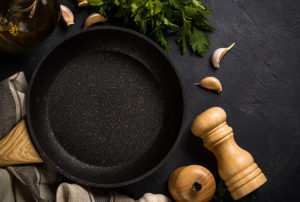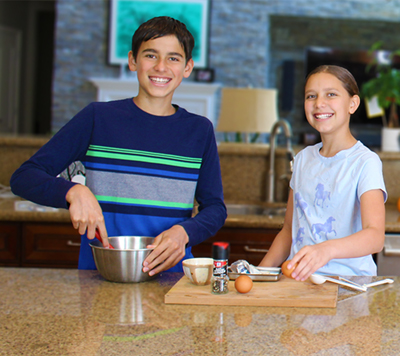What is a Nonstick Pan?
A nonstick pan is a type of pan that uses a special nonstick coating. A variety of pans use nonstick coatings, including frying pans, saute pans, baking pans, and saucepans. Nonstick pans are popular because they can help prevent foods from sticking to the pan and burning. Nonstick pans may not be able to hold up to high heats and should only be used on the stove. You should not use metal utensils with most nonstick pans to avoid scratching the coating. To keep nonstick pans lasting as long as possible, you should hand wash them.
What are Nonstick Pans Used For?
Nonstick pans are used for most aspects of cooking, such as sauteing, browning, stir-frying, and some kinds of frying. Nonstick pans are commonly used with foods that are prone to sticking, like tomatoes in sauce or roux for a cheese sauce. Because some nonstick pans have ridges in the bottom, they may also be used to create grill marks.

What are the Different Types of Nonstick Pan?
- Ceramic
- Enamel
- PTFE
Ceramic
Ceramic nonstick pans are usually metal on the inside with a ceramic or ceramic-style plating on the outside. Ceramic nonstick pans can withstand higher temperatures than other nonstick pans.
Enamel
Enamel nonstick pans are cast iron pans wrapped in an enamel coating. Enamel coatings are usually white or light-colored and are prone to staining. The coating may crack, but enamel nonstick pans are usually durable.
PTFE
PTFE is the traditional type of nonstick coating. This coating is typically black or dark gray and some pans have a red circle in the bottom of the pan. Some nonstick pans may have a metal rim around the opening of the pan. It is prone to scratching and flaking, which means that the nonstick pan may need to be replaced. This type of pan is also usually not suited for high heats.
Recipes Using A Non Stick Pan
Diner-Style Omelet
The nonstick coating on a nonstick skillet is perfect for making omelets that don’t stick to the pan. In the pan, melt butter over medium heat. Once the butter melts, add in eggs that have been whisked together and seasoned with salt and pepper. Stir the eggs in the pan, pushing the edges to the center and tilting the pan so that the raw egg moves to come in contact with the hot pan. Once the eggs set, add in your favorite toppings, like shredded cheddar, fresh herbs, and roasted peppers. Fold the omelet in thirds and serve.
Fontina, Chard and Olive Frittata
Like an omelet, frittatas slide out easily when made on a nonstick skillet. To make this one, sauté onions and garlic with oil and butter. In a separate bowl, whisk eggs, half and half, sliced olives, shredded fontina, cooked chard, and pour into the skillet. Cook the frittata until it is firm and brown around the edges and flip with a spatula to cook on the other side. Serve with chopped fresh herbs like parsley and basil.
Crepes with Whipped Ricotta and Berries
In a blender, combine milk, egg, flour, salt, and oil, and blend until smooth. Refrigerate the mixture for at least 2 hours. In a nonstick skillet, ladle in some batter and tilt the pan to spread thinly around the pan. Cook the crepe for 1 to 2 minutes on each side and fill them with berries and whipped ricotta cheese sweetened with maple syrup.
Seared Salmon
Use a non-stick grill or frying pan to cook salmon fillets indoors. In a zip-top bag, add soy sauce, garlic, grated ginger, and brown sugar. Shake until combined and add in salmon filets. Shake the bag once more and refrigerate for a few hours. In your non-stick pan, add oil and let it heat up. Sear the marinated salmon filets for 3 to 5 minutes on each side or until the flesh starts to flake. Serve with steamed veggies like broccoli or cauliflower and steamed rice.
Bechamel Sauce
Make a classic French “mother sauce” that is perfect for making the base for a cheese sauce. In a nonstick saucepan, add butter and flour to make a roux. Cook the roux until the paste is golden brown. Add milk and continue cooking the sauce until it thickens. Season with ground nutmeg, salt, pepper, and finish with parmesan cheese.


